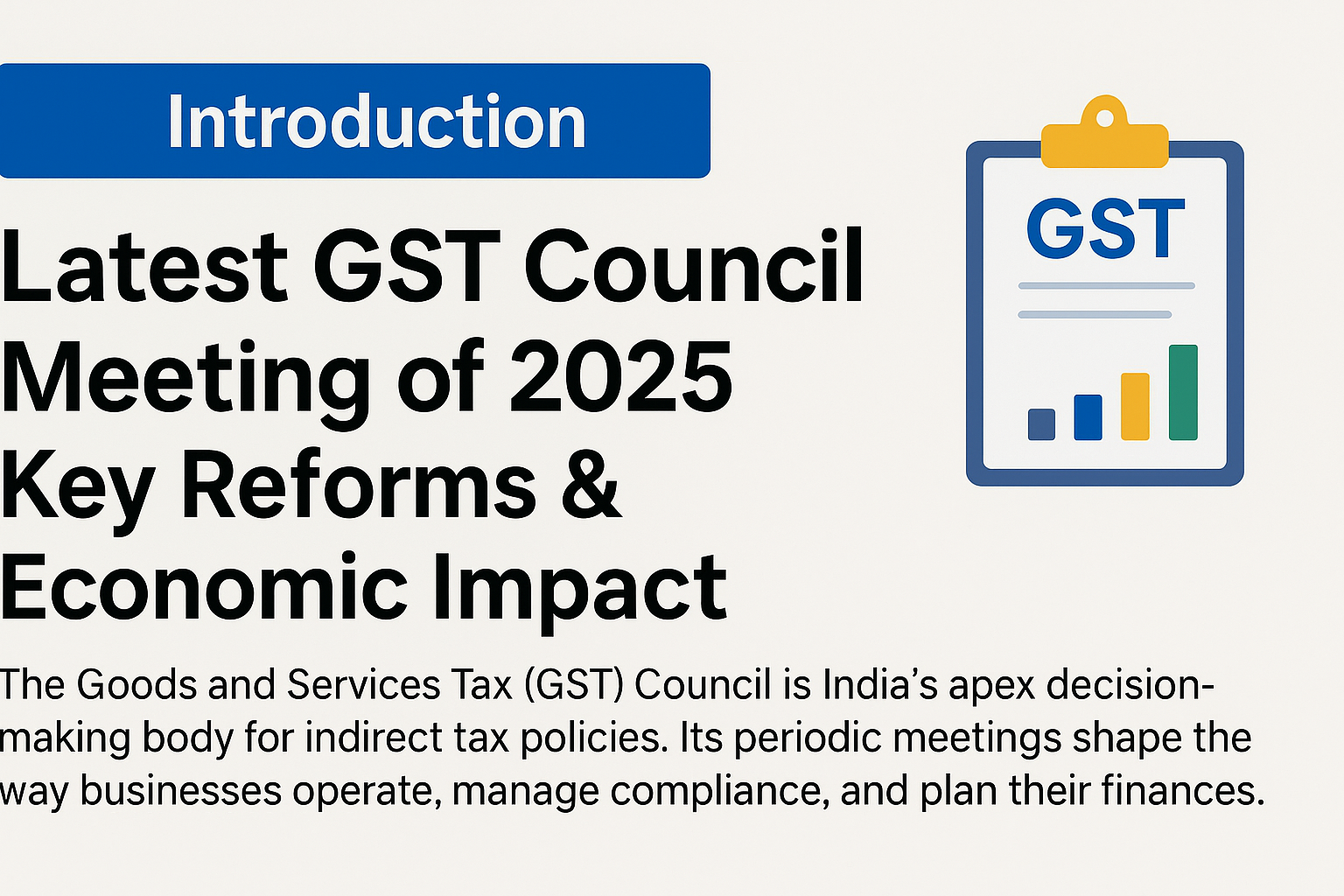Latest GST Council Meeting Highlights: Key Decisions for Businesses

Introduction
The Goods and Services Tax (GST) Council is India’s apex decision-making body for indirect tax policies. Its periodic meetings shape the way businesses operate, manage compliance, and plan their finances.
The *latest GST Council meeting of 2025* introduced significant reforms — from tax rate changes to compliance simplifications. For business owners, entrepreneurs, and taxpayers, these updates hold important implications.
In this blog, we’ll break down the highlights of the meeting, explain what each decision means for different industries, and explore the potential economic impact.
What is the GST Council and Why Its Meetings Matter?
The *GST Council* is headed by the Union Finance Minister and includes finance ministers from all states.
It decides *GST tax rates, compliance norms, exemptions, and policies.*
Its decisions impact everything — from consumer prices to corporate taxation and government revenues.
For businesses, staying updated on council decisions is crucial to ensure compliance and to adjust pricing, sourcing, and supply chain strategies.
Key Highlights of the Latest GST Council Meeting
1. GST Rate Revisions
* *Food Processing Sector:* GST on packaged food items like ready-to-cook meals reduced from 12% to 5% to boost affordability.
Electric Vehicles (EVs):* GST on EV batteries cut from 18% to 12% to encourage green adoption.
Luxury Services:* GST on five-star hotel stays above ₹7,500 increased from 18% to 20%.
*Impact on Businesses:*
* FMCG firms gain from lower taxes on packaged foods.
* EV manufacturers benefit from lower input costs.
* Hospitality industry faces a higher tax burden, potentially affecting luxury tourism.
2. Simplified GST Return Filing for MSMEs
The Council approved a *single quarterly return* for businesses with a turnover up to ₹5 crore, replacing multiple monthly filings.
Impact:
Relief for over 70% of small and medium enterprises.
Lower compliance costs and reduced paperwork.
Encourages more small businesses to join the formal tax net.
3. Input Tax Credit (ITC) Reforms
ITC claims can now be availed up to *90 days from the invoice date* (previously 60 days).
Businesses can reconcile invoices quarterly instead of monthly.
Impact:
Improves cash flow for businesses.
Reduces disputes during audits.
4. GST on Online Gaming and Digital Services
The Council decided to levy *28% GST on online gaming and fantasy sports platforms*.
Subscription-based digital services like streaming and SaaS tools continue under the 18% slab.
Impact:
Startups in the gaming sector face higher taxation, which may impact growth.
Consumers may see increased charges for gaming credits.
5. Stronger Anti-Evasion Measures
The government will roll out *AI-based invoice verification* across all GST filings.
States and the Centre to share real-time data to detect fraud faster.
Impact:
Stricter compliance checks for businesses.
Reduced fake invoicing and tax evasion.
6. Petroleum Products Under Consideration
The Council discussed but deferred the decision on bringing *petroleum and natural gas under GST.*
Currently, these items are taxed outside GST and attract excise and VAT.
A move under GST would simplify pricing but requires state consensus.
Business Reactions to the Decisions
MSMEs:* Welcomed the quarterly return system as a big relief.
FMCG Players:* Expect a sales boost due to reduced GST on packaged food.
Hospitality Industry:* Expressed concerns about higher GST rates impacting tourism competitiveness.
EV Manufacturers:* Applauded the cut in battery tax rates, calling it a step towards sustainability.
How These Decisions Impact Consumers
Cheaper packaged food and EVs* may attract more buyers.
Luxury hotel stays* may get costlier.
Online gamers* will likely pay more due to higher GST.
Economic Significance of the Meeting
1. Revenue Neutrality:* While some sectors received tax relief, higher GST on luxury services and online gaming is expected to balance revenue.
2. Boost to Green Economy:* Lower taxes on EV components support India’s clean mobility goals.
3. Ease of Doing Business:* Simplified returns improve India’s ranking in business-friendliness.
4. Digital Monitoring:* Stricter compliance measures enhance transparency.
Challenges Ahead
Rate Rationalisation Pending:* Multiple tax slabs still confuse businesses.
Gaming Sector Concerns:* Heavy taxation could discourage investment.
Petroleum Under GST:* Until resolved, fuel pricing will remain complex.
Conclusion
The *latest GST Council meeting of 2025* shows a balanced approach — easing compliance for MSMEs, supporting green initiatives, but also ensuring revenue through higher taxes on luxury services and gaming.
For businesses, the decisions mean adjusting pricing strategies, reviewing supply chains, and upgrading compliance systems. For consumers, the impact will be mixed — some products get cheaper, while others cost more.
Overall, the reforms signal that India’s GST framework is evolving towards greater inclusivity, efficiency, and digital monitoring — setting the stage for stronger economic growth.
FAQs on GST Council Decisions
*Q1. How often does the GST Council meet?*
Usually every 2–3 months, but urgent meetings may be called.
*Q2. Which GST decision impacts MSMEs the most?*
The new quarterly return filing for businesses under ₹5 crore turnover.
*Q3. Why is GST on online gaming so high?*
The government considers it a luxury/entertainment service and aims to curb addictive usage.
*Q4. Will petroleum come under GST soon?*
Not yet. States are still debating revenue implications.
*Q5. What is the biggest benefit for businesses from this meeting?*
Simplified compliance and extended ITC timelines for better cash flow.